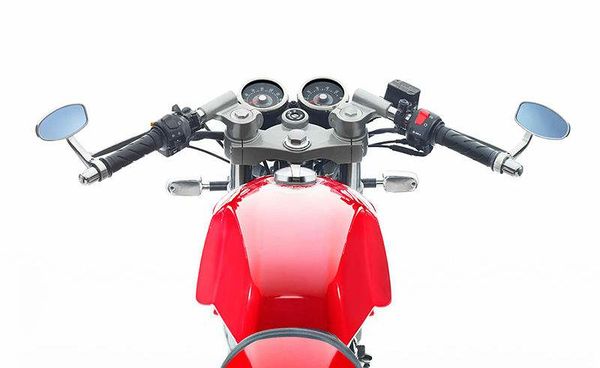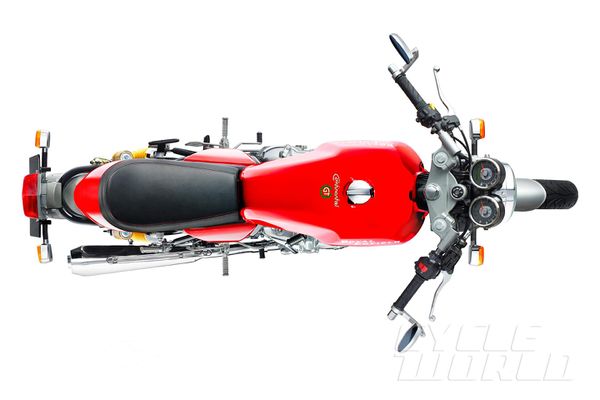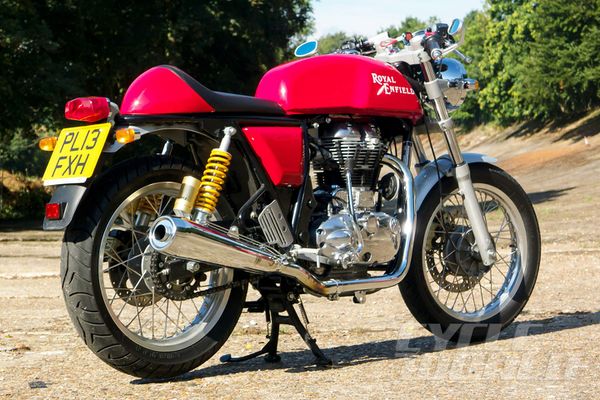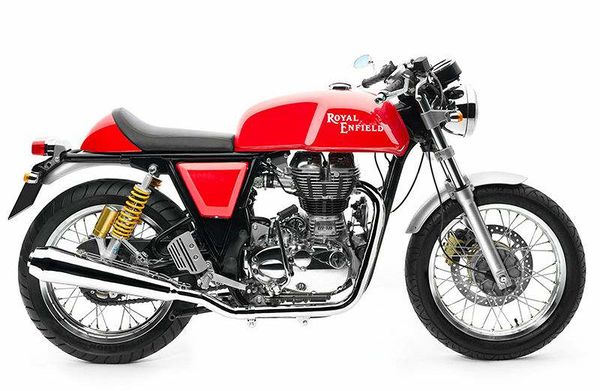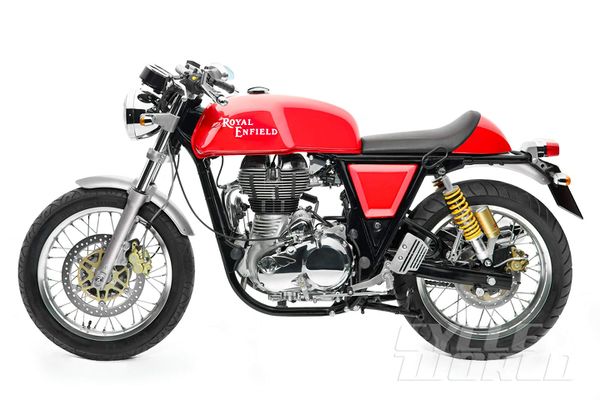Royal Enfield Continental GT535
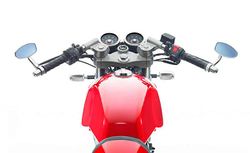 |
|
| Royal Enfield Continental GT535 | |
| Manufacturer | |
|---|---|
| Production | 2014- 16 |
| Engine | Four stroke, single cylinder, twinspark |
| Compression ratio | 8.5:1 |
| Ignition | Digital electronic ignition |
| Battery | 12V, 14Ah |
| Transmission | 5 Speed, constant mesh |
| Frame | Twin downtube |
| Suspension | Front: Telescopic fork, Ø 41 mm Rear: Twin shock, Paioli, gas charges with adjustable preload |
| Brakes | Front: Single floating disc, Ø 300 mm, 2 piston floating caliper Rear: Single disc, Ø 240 mm / single floating caliper |
| Front Tire | 90/90-19 |
| Rear Tire | 120/80-18 |
| Wheelbase | 1370 mm / 53.9 in |
| Seat Height | 800 mm / 31.5 in |
| Weight | 187 kg / 412 lbs (wet) |
| Fuel Capacity | 14.5 L / 3.8 US gal |
| Manuals | Service Manual |
Engine[edit | edit source]
The engine was a Air cooled cooled Four stroke, single cylinder, twinspark. The engine featured a 8.5:1 compression ratio.
Drive[edit | edit source]
Power was moderated via the Wet, multiplate.
Chassis[edit | edit source]
It came with a 90/90-19 front tire and a 120/80-18 rear tire. Stopping was achieved via Single floating disc, Ø 300 mm, 2 piston floating caliper in the front and a Single disc, Ø 240 mm / single floating caliper in the rear. The front suspension was a Telescopic fork, Ø 41 mm while the rear was equipped with a Twin shock, Paioli, gas charges with adjustable preload. The Continental GT535 was fitted with a 14.5 L / 3.8 US gal fuel tank. The wheelbase was 1370 mm / 53.9 in long.
Photos[edit | edit source]
Overview[edit | edit source]
Royal Enfield Continental GT 535
review If heritage and authenticity are what motorcycles are all about going forward, then no company is better equipped to prosper than Royal Enfield. The companys roots date back to the 19th century, and its Bulletwhose engine the new Continental GT is based uponwas first produced in 1933. That makes the Bullet the oldest motorcycle in the world in continuous production. In 1967, RE shuttered its plant in Redditch, England. But by then, its subsidiary in India had already been stamping out Bullets for years, for use not only by the Indian police and military, but for upscale civilians as well. In India, where there are millions of 125 and 250cc bikes providing transportation for 1.2 billion inhabitants, the Bullet in 350 and 500cc sizes is an aspirational motorcycle. Harley-Davidson in the U.S. has nothing on RE in India, which claims 95 percent of the over-250cc home market. That number is aided by a 60-percent tariff on imported motorcycles that pushes bikes like the 883 Sportster and
CBR600RR into the realm of exoticaand which has led H-D and others to open their own Indian plants in recent years.
The rise of the Indian middle class has driven demand for its bikes through the roof lately, says Siddhartha Lal, Managing Director and CEO of Eicher Motors Ltd., Royal Enfields parent company. In 2010, Lal says, RE sold 50,000 motorcycles. By 2012, the number had doubled to 100,000which led to the building of a new state-of-the-art factory near Madras, which just came on line in April. This Oragadam plant has a production capacity of 175,000 bikes for 2013and gives RE the ability to scale up to 500,000 per year. Lal, it should be noted, also serves as Chairman of Eicher Polaris Private Limited, which ties Royal Enfield to our homegrown Polaris. Yes, someday there very well could be an Indian Indian.
With all that going on, it seemed like a good time to come out with a truly new Royal Enfield, carrying forward no parts from the original Bullet. Okay, almost no parts: Bolted solidly in four places in the Continental GTs engine bay is the same old unit-construction EFI Bullet Single, punched out to 535cc (87.0 x 90.0mm) and now powering a lovely little Continental GT with a steel frame designed by Harris Performance, beautiful new bodywork courtesy of Xenophya Design (both U.K. companies), brakes from Brembo, alloy Excel rims with fat spokes, Paioli shocks, 41mm fork tubes and all the right café racer design elements. The red paint, thanks to the new paint shop in the new factory, looks very nice, though the silver metalflake applied to the triple-clamps and fork sliders isnt exactly period correct.
Lets Go for a Ride
If revenge (following 300 years of colonialism) is a dish best
served cold, what better place to introduce your new Indian-built British
classic than London?
Hit the starter (or kick the kickstarter) and the air-cooled,
fuel-injected thumper mumbles to life more than rumbles, even with the louder
accessory exhaust our test bike is wearing. Injection mapping isnt great;
theres a dead spot off idle that requires a few revs to bypass when leaving
from a stop (sometimes it flames out anyway), but once rolling, theres good
torque down around 2000 to 3000 rpm, enough so that second gear feels just as
strong as first. RE claims 32 foot-pounds at 4000 rpm. Horsepower maxes out at
29.1 at 5100 rpm according to REs specs (which seems about right), and past
that, the tachometer needle is in no hurry to get to the cut-out at 5500 rpm.
Throbbing around London at 40 and 50 mph is no problem; in
fact, its a gas, but on the motorway toward Brighton, a bit over 80 mph
indicated is about all the Continental GT will do on level pavement in full
tuck. If its nostalgia you want, the Conti provides a modern appreciation for
why The Ton was such a big deal. Dialing it back to a sedate 65 has you in the
meat of the clip-on bars vibration zone, which feels like a nice vibra-massage
at first but would grow annoying over a distance. All in all, it feels like a
Honda CBR250R would give the Conti a real run for its money, which is a little
disappointing for a bike with twice the displacement. Then again, the CBRs just
another plastic motorcycle, but everybody in Londons eyeballing the Continental
GT (or is it my new Vanson jacket?). We drew the most attention from a Royal
Parks official when we attempted to shoot a photo in one of the Kings game
reserves, where the speed limit is 20 mph: Weve already had one fatality
today! the red-faced official fumed. A badger!
For sure, this bikes not about horsepowerbut the difference
between the Contis claimed 29 and the 38 or so put out by the Guzzi V7
Racer we tested last year, feels huge. Compared to its target, the
Thruxton, the Conti GT makes about half the power
and weighs more than 80 pounds less, if REs claimed dry weight of 387 lb. is
accurate. The GT could probably rule a tight downhill set of curves on its
Pirelli Demons, but purely from a functional standpoint it feels like a lovable
antique when compared to the 337-lb., 68-hp KTM
690 Duke.
Eureka! Reliable modern bikes that look like antiques are just
what many doctors are ordering latelyto be transported to a happy, simpler time
without the need to bring tools. Hats off to Royal Enfield for producing a bike
that will appeal to mature riders while still being affordable enough, at around
$7200, to get the attention of hipsters.
If youre okay with the engine, the rest of the Continental GT
is more friendly to ride than it looks. Nicely compliant suspension feels just
about right for my 155-pound body; the seat is thick and comfy if pretty narrow;
the rear of the tank is a good shape; and those clip-ons are mounted on top of
the triple-clamps so youre left with a near-standard riding position. The
five-speed gearbox works fine, and the disc brakes are powerful enoughbut
theres no lever adjustment for the front so you had better hope it fits your
hand. The rest of the controls and switchgear are also not quite up to current
Japanese tactility, but theyre closeand with a few minor adjustments to take
the play out of the throttle, etc., the Royal Enfield Continental GT could be
tailored into a sweet little runabout.
However it works and sells, the GT is a hugely significant
motorcycle. Whether it captures American hearts and minds is beside the point:
If these dont sell well in the U.S., theres a long list in India thatll
gladly pay a quarter the cost of a Sportster all day long for a sporty
Continental GT. And Siddhartha Lal also sees it as a viable mid-level motorcycle
for South America, where countries like Brazil are busting out as fast as India.
(In addition to his role with Eicher, Lal is also involved with the World
Economic Forums Transforming Urban Mobility initiative. Its not always about
us First Worlders.) Meanwhile, flush with cash and full of confidence, Royal
Enfields got 500 people working on new projects. If theyre as motivated as the
people it sent to launch the Continental GT in London, the motorcycle world had
better watch out.
Source
| Make Model | Royal Enfield Continental GT 535 |
|---|---|
| Year | 2014- 16 |
| Engine Type | Four stroke, single cylinder, twinspark |
| Displacement | 535 cc / 32.6 cu in |
| Bore X Stroke | 87 x 90 mm |
| Cooling System | Air cooled |
| Compression | 8.5:1 |
| Lubrication | Wet sump |
| Engine Oil | 15W50 API, SL grade JASO MA |
| Exhaust | One-into-one, chrome |
| Induction | EFI, Keihin |
| Ignition | Digital electronic ignition |
| Battery | 12V, 14Ah |
| Starting | Electric and kick |
| Max Power | 21.4 kW / 29.1 hp @ 5100 rpm |
| Max Torque | 44 Nm / 4.5 kgf-m / 32.5 lb-ft @ 4000 rpm |
| Clutch | Wet, multiplate |
| Transmission | 5 Speed, constant mesh |
| Final Drive | Chain |
| Frame | Twin downtube |
| Front Suspension | Telescopic fork, Ø 41 mm |
| Front Wheel Travel | 110 mm / 4.3 in |
| Rear Suspension | Twin shock, Paioli, gas charges with adjustable preload |
| Rear Wheel Travel | 80 mm / 3.1 in |
| Front Brakes | Single floating disc, Ø 300 mm, 2 piston floating caliper |
| Rear Brakes | Single disc, Ø 240 mm / single floating caliper |
| Wheels | Alloy, laced wire spokes |
| Front Tire | 90/90-19 |
| Rear Tire | 120/80-18 |
| Dimensions | Length: 2180 mm / 85.8 in Width: 800 mm / 31.5 in Height: 1080 mm / 42.5 in |
| Wheelbase | 1370 mm / 53.9 in |
| Seat Height | 800 mm / 31.5 in |
| Wet Weight | 187 kg / 412 lbs |
| Fuel Capacity | 14.5 L / 3.8 US gal |
